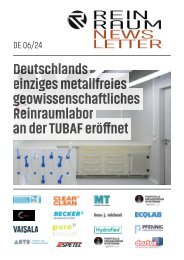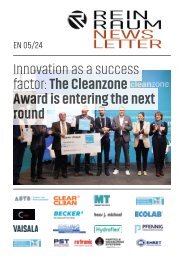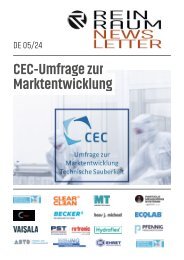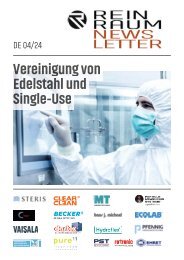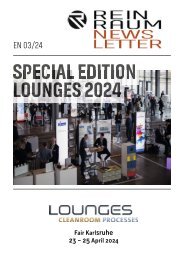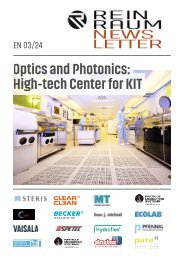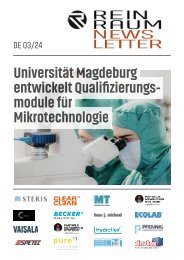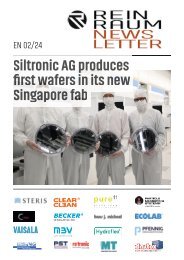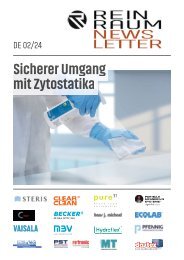Newsletter_12-2022_EN
Fachbeiträge, redaktionelle Beiträge und Veranstaltungen In einer sich schnell entwickelnden Branche sind aktuelle Informationen wichtig. reinraum online bietet einerseits Interessierten die Möglichkeit, sich aktuell und umfassend über die Reinraum-Branche zu informieren. Andererseits können Unternehmen und Personen die Plattform nutzen, Fachbeiträge, redaktionelle Artikel und Firmennews zu veröffentlichen. Ein Veranstaltungskalender ergänzt das Informationsangebot. Der ExpertenPool hilft bei der Profi-Suche: WER macht WAS im Reinraum.
Fachbeiträge, redaktionelle Beiträge und Veranstaltungen
In einer sich schnell entwickelnden Branche sind aktuelle Informationen wichtig. reinraum online bietet einerseits Interessierten die Möglichkeit, sich aktuell und umfassend über die Reinraum-Branche zu informieren. Andererseits können Unternehmen und Personen die Plattform nutzen, Fachbeiträge, redaktionelle Artikel und Firmennews zu veröffentlichen. Ein Veranstaltungskalender ergänzt das Informationsangebot.
Der ExpertenPool hilft bei der Profi-Suche: WER macht WAS im Reinraum.
You also want an ePaper? Increase the reach of your titles
YUMPU automatically turns print PDFs into web optimized ePapers that Google loves.
www.reinraum.de<br />
NEWSLETTER<br />
www.cleanroom-online.com Edition <strong>EN</strong> <strong>12</strong>-<strong>2022</strong> | Page 3/42<br />
Overall impact of new Annex 1<br />
in pharmaceutical industry<br />
Annex 1 and sterilization process: an interview with Tim Sandle<br />
The revision of Annex 1 is requiring a major effort from the life sciences industry; from ‘setting up new processes, to training staff, to managing<br />
noncompliance, the industry needs to adapt particularly to new requirements regarding contamination control strategy and the<br />
essential elements needed to develop a robust sterility assurance system.<br />
One of the most discussed processes involves autoclaving and the risks associated with it.<br />
We talked about it with Tim Sandle, a microbiologist, author and science journalist, known as one of the leading experts in the field.<br />
Our interview opens with an assessment of the overall impact of the<br />
new Annex 1 on contamination control strategies in the pharmaceutical<br />
industry. Dr. Tim Sandle, the new Annex 1 revision is distinguished<br />
by a “holistic” view of contamination control. What are the most<br />
immediate consequences of this new approach?<br />
Many facilities have developed approaches to contamination control,<br />
but the call within the Annex is for pulling everything together to<br />
provide a holistic overview of the facility, the rationale, the gaps, the<br />
level of risk for each gap, and the remediation steps. A contamination<br />
control strategy is a system that considers all the integral elements of<br />
pharmaceutical product manufacturing. This is best achieved using<br />
quality risk management principles and supporting risk assessments<br />
for contamination control and monitoring (the detectability of contamination<br />
event).<br />
As a governing ethos, processes, equipment, facilities and manufacturing<br />
activities should be managed in accordance with risk management<br />
principles that provide a proactive means of identifying,<br />
scientifically evaluating and controlling potential risks to quality.<br />
The strategy at each facility will vary, but common themes will<br />
include: microbial contamination, cleaning and disinfection, sterility<br />
assurance, facility design, chemical and particle contamination.<br />
Outside of the microbial, other forms of contamination that can<br />
arise from mix-ups, damaging primary or secondary packaging, distribution<br />
problems, and environmental fluctuations. Overall, a focus will<br />
need to be with reducing contamination likelihood and cross-contamination<br />
potentials. This needs science and technical procedures and<br />
controls.<br />
The format would be as one document or series of connected documents<br />
developed to reflect the site-wide strategy for minimizing<br />
contamination control.<br />
Importantly, the strategy should be a living document and be updated<br />
in relation to change controls, process development, recurrent<br />
deviations and in relation to other quality records.<br />
Challenges in sterilization processes<br />
What are the challenges facing the pharmaceutical industry<br />
in sterilization processes with respect to the requirements of<br />
the new Annex1?<br />
Perhaps the most significant change is in relation to equipment sterilization<br />
when used for aseptic processing. The 2017 draft stated that critical<br />
surfaces with direct impact need to be sterilized (such as a filling<br />
manifold or stopper bowl); however, with the 2020 revision this now<br />
requires direct and indirect contact parts to be sterilized. This could<br />
present challenges to facilities with both isolators and RABS devices.<br />
There is a specific update for freeze-dried products in terms of<br />
freeze-dryers (or lyophilizers). This is for lyophilizers which are manually<br />
loaded or manually unloaded. Here the freeze-dryers should be<br />
sterilized before each load.<br />
Other important Annex 1 points include the requirement that the<br />
feed water to a pure steam (clean steam) generator should be appropriately<br />
purified, to achieve the required chemical and endotoxin<br />
levels, as assessed by the Water-for-Injections pharmacopeial monitoring<br />
and testing requirements. With the chemical requirement, this<br />
is because steam used as a direct sterilizing agent must not contain<br />
additives at a level which could cause contamination of product or<br />
equipment. This part of the process needs to be validated. The steam<br />
must also consistently meet the parameters for non-condensable gases,<br />
dryness value (dryness fraction) and superheat.<br />
The Annex also specifies that each item sterilized needs be inspected<br />
for damage, packaging material integrity and moisture on removal<br />
from the autoclave. Any item found not to be fit for purpose, either damaged<br />
or where there is evidence of a ‘wet load’, should be removed<br />
from the manufacturing area and an investigation performed.







